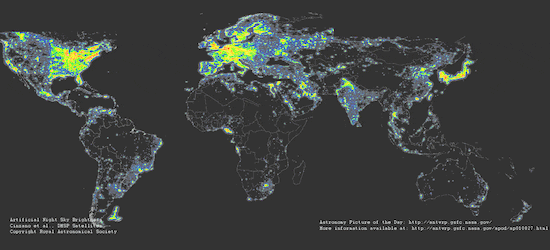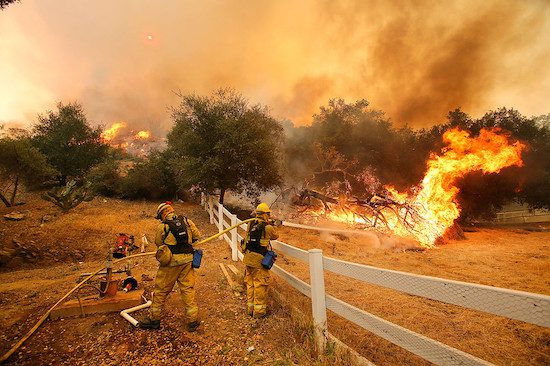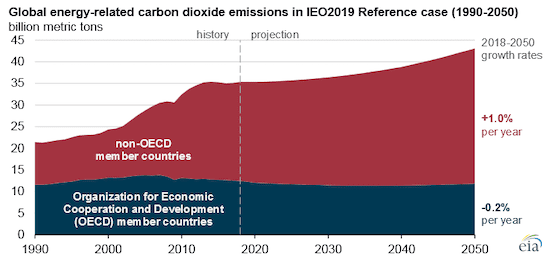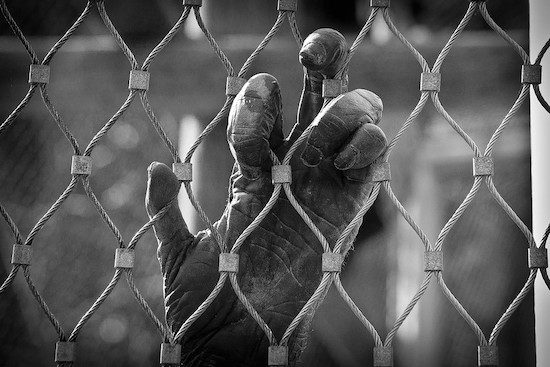


International Dark-Sky Association: In many places across the globe, particularly in major cities, the night sky has been reduced from a breathtaking show of hundreds of stars to a diffuse glow through which only a handful of stars can be seen. Light pollution has been a known issue for decades. But we’ve only recently been able to access the tools and technology to better understand which sources contribute the most to light pollution, what impact it has on the natural world (like changing the resting and feeding behavior of wildlife), and how to develop smarter policies to protect the night. In the coming weeks, citizen scientists can participate in Globe at Night, an annual, worldwide, kid-friendly campaign asking individuals to measure the quality of the night sky where they live. You don’t have to leave your backyard (or porch or patio) to take night sky measurements—and reporting results only takes a moment using the handy Globe at Night online web app. Your reported measurements are added to other reports from around the world where they are held in an open-source database. With these measurements, scientists can see how the quality of the night is changing all around the world. Your measurements will help to develop targeted policies and guidelines to help solve the problem of light pollution.
>>>Take part in the worldwide Globe at Night campaign from March 14-24, 2020.
Lady Freethinker: In China’s cruel and dangerous wild animal trade, millions of bats, civets, snakes, badgers, monkeys and other animals face brutal torture and slaughter each year, putting humans at risk of diseases such as rabies and coronavirus, which may have originated at a wild animal market. These markets also often sell dogs and cats, who are stuffed into tiny cages, transported unbearably long distances and bludgeoned to death or burned alive. Finally recognizing the severity of the situation, China has temporarily halted the trade and human consumption of wild animals, but a temporary ban is not enough. China must ban this practice permanently. These innocent animals are subjected to agonizing suffering as they are snatched from their homes and sold to meat markets. The horrendous wildlife trade is also a severe health threat to humans, and conservationists believe the only way to prevent future virus epidemics is to permanently ban this dangerous and unhealthy industry.
>>>Urge Chinese Ambassador Cui Tiankai to call for a permanent ban on China’s wild animal trade and the consumption of dog and cat meat.
Care2: Evidence shows that more than 2 million child laborers as young as 10 years old work on cocoa farms in West Africa, helping to produce a significant amount of the chocolate consumed in the U.S. That includes chocolate produced for one of the world’s largest candy companies, Hershey’s. As far as child labor goes, cocoa work is considered some of the worst work. Daily tasks include deploying dangerous pesticides, chopping brush and cocoa pods with machetes, and lifting excessively heavy bags. Impoverished kids who are sent to work on these farms are subjected to body-breaking work and do not attend school. Many of these children are also trafficked and forced to lie about their ages under the watchful eyes of coercive farmers. For two decades, chocolate companies have set goals to eradicate child labor on these farms, but they come up short each time.
>>>Urge Hershey’s CEO Michele Buck to guarantee their chocolate isn’t made using child labor.
Letter to the editor…

Replying to “Insurers Should Support People, Not the Fossil Fuel Industry,” by Tony Dunn:
Thank you so much for this very important article. Here in Australia, I haven’t given a thought about the insurance company I’m insured with. This will change with my next renewal, which is due very soon. I will be asking many questions before they receive any payment from me. I live on a tiny farm amongst bushland in Victoria, Australia, and only discovered your posts by accident a few months ago. I try to read all I can on the issue of our climate emergency and do my best to contribute as little as possible to the harm that we humans do, not only to the environment, but to our fellow human beings. I’m afraid that unless things change rapidly there will be only misery for my grandson’s generation. So thank you for waking me up to another issue and I will endeavor to do my best in that area as well. Sadly, I don’t know many people of my generation willing to make the effort as it isn’t easy to take the steps required to live this way. —Susan Brinksma (Victoria, Australia)
Cause for concern…

- World carbon dioxide emissions are projected to increase (U.S. Energy Information Administration)
- Methane emitted by humans vastly underestimated, researchers find (Lindsey Valich, University of Rochester)
- Extreme weather could bring next recession (Karen Nikos-Rose, University of California – Davis)
- America’s ‘recycled’ plastic waste is clogging landfills (Erin McCormick, The Guardian)
- Trump taps former chemical industry executive to lead consumer watchdog agency (Lisa Friedman, The New York Times)
- Trump gas wells could block 6,000-year-old pronghorn migration route (Cassidy Randall, The Guardian)
- Bald eagles across U.S. are dying from lead poisoning (Alaa Elassar, CNN)
- Nearly 50 rhinos killed in Botswana in 10 months as poaching surges (Agence France-Presse via Jakarta Post)
- Rare bats in decline due to overhunting in Indonesia and the Philippines (City College of New York)
- ‘Bee-washing’ hurts bees and misleads consumers (Lila Westreich, The Conversation)
- Consumers unconsciously use a single ethical aspect as an excuse for a less moral behavior regarding other aspects of the same product (Karlsruher Institut für Technologie, ScienceDaily)
- Plight of endangered animals represented by powerful pixelated images representing their “disappearance” (Emma Taggart, My Modern Met)
Round of applause…

- Coronavirus: What pet owners can do to help prepare (Sally Jones, Canine Journal)
- New green technology generates electricity ‘out of thin air’ (University of Massachusetts Amherst)
- Bridges for animals? Why wildlife crossings are worth it (Matt Skroch, Pew Charitable Trusts)
- Kenya bans commercial slaughter of donkeys (BBC News)
- Teen wins national award for alternatives to real-frog dissection (Keri Brenner, Marin Independent Journal)
- Urbanization in Bangladesh is destroying avian habitat, so students are giving wild birds secure homes (The Daily Star)
- Stella McCartney made a powerful animal rights statement at Paris Fashion Week (Lara Faye, Stylist)
- The world’s first vegan culinary school opening in Colorado this summer (Brandon Kirkwood, Vegan News)
- Vegan activists risking jail to expose farm ‘secrets’ (Nick Whigham, Yahoo News Australia
- Vegan Saudi prince believes plant-based meat will be cheaper than animal flesh by 2025 (Totally Vegan Buzz)
- Hungry for vegan love? It might be time to give this new plant-based dating app a spin (Miranda Larbi/Metro)
Parting thought…

“To treat a chimpanzee as if he or she had no right to liberty protected by habeas corpus is to regard the chimpanzee as entirely lacking independent worth, as a mere resource for human use, a thing the value of which consists exclusively in its usefulness to others.” —Court of Appeals Associate Judge Eugene M. Fahey
Earth | Food | Life (EFL) explores the critical and often interconnected issues facing the climate/environment, food/agriculture and nature/animal rights, and champions action; specifically, how responsible citizens, voters and consumers can help put society on an ethical path of sustainability that respects the rights of all species who call this planet home. EFL emphasizes the idea that everything is connected, so every decision matters.
Click here to support the work of EFL and the Independent Media Institute.
Questions, comments, suggestions, submissions? Contact EFL editor Reynard Loki at [email protected]. Follow EFL on Twitter @EarthFoodLife.